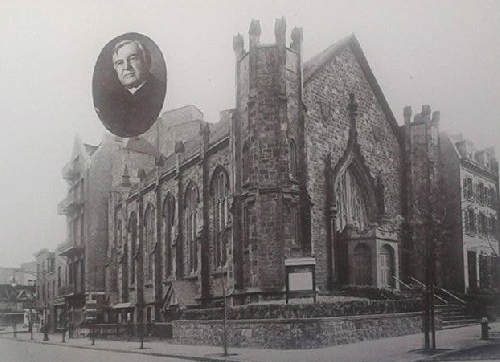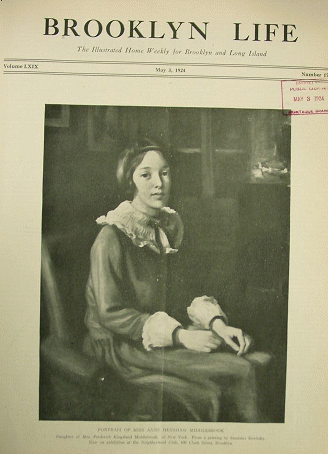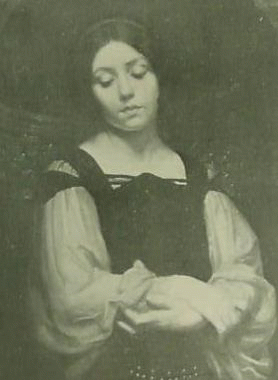| Back OpEd News | |||||||
|
Original Content at https://www.opednews.com/articles/An-Era-That-Has-Gone-VIII-by-Peter-Duveen-Drawing_Exhibition_Painting_Paintings-160906-286.html (Note: You can view every article as one long page if you sign up as an Advocate Member, or higher). |
|||||||
September 6, 2016
An Era That Has Gone VIII
By Peter Duveen
A year and a half after his landing at Ellis Island, Stanis begins to strengthen his foothold in the art world with the help of his friends, the Henshaws. Two shows and a public appearance are occasions for showcasing his work and the philosophy behind it.
::::::::
As the aspiring impresario of sorts that she was, Cory wanted to showcase Stanis's work as a way of introducing him to Brooklyn Heights society. The success of this venture hinged as much on Cory's own currency with the public as it did with Stanis's stature as an artist. Much of the readership of Brooklyn Life was likely aware that Cory was a scion of the Middaghs, who, as we have already mentioned, were wealthy landowners of Heights property in a bygone era, adding a bit of gravitas to whatever she might say or do. Brooklyn Life itself, edited as it was by Cory's elder brother, and for which she continued to contribute as a writer, was well subscribed to. It was a significant force in shaping the Brooklyn Heights cultural scene, focusing as it did on local events and matters that the dailies were often forced to let fall through the cracks because of their emphasis on national and international news. Cory's amusing and endearing column about Willie Winkie and his exploits was viewed, if not read, by some 30,000 readers who purchased the weekly periodical, which hit the stands and the mailboxes like clockwork every Saturday.
Setting her mind to the task at hand, Cory tweaked her connections at the Neighborhood Club--the New Church's cultural arm--and in short order was able to schedule Stanis for a month-long slot from late April through the end of May, 1924.

The Church of the Neighbor, with photo portrait of Swedenborgian notable Dr. John C. Ager.
(Image by James H. Callender, Yesterdays on Brooklyn Heights, 1927) Details DMCA
With the vibrancy of the cultural scene in Brooklyn, the New Church, also known as the Church of the Neighbor, and sometimes as the Church of the New Jerusalem, had become an icon in Brooklyn's crown of cultural jewels. Standing on the corner of Monroe and Clark Streets, the edifice was purchased by the Swedenborgians from another Christian denomination in the 19th Century. More recently, the church had built an annex where it housed a book store and a meeting room, and after its completion, began using the upstairs space to exhibit quality art by local talent, including the work of many of the Ovington Building artists, their studios being only few doors away.
As an exhibition of etchings by Andrew T. Schwartz ended, Stanis's show was set to begin. Every conceivable piece of work he had finished in the year and a half since he arrived in New York was dusted off and touched up where the occasion demanded, along with a few works he managed to scurry out of Europe when he emigrated to the the United States. Certainly Stanis had begun to establish a record of accomplishment as a portrait painter in the year and a half since he arrived at Ellis Island, although he was still struggling to bridge the cultural abyss between Europe and America. As a matter of fact, his herculean efforts to master a new language, matched with the unfamiliar and at times hostile environment in New York, put him in a psychological space that blocked all his efforts to even begin a painting or drawing. It was his meeting with the Henshaws and their encouragement that provided fertile ground for his genius to blossom into actual accomplishments.
If his best efforts bore fruit, it would not be the first time Stanis had excelled in unfamiliar territory. As a Polish-Jewish artist, he had managed to collect a good number of clients in a region of Germany that would eventually become a hotbed of anti-Jewish sentiment. New York, then, as strange and foreign an environment as it may have been to Stanis at first, should not have presented him with insurmountable obstacles in comparison. But New York was no piece of cake to conquer either, particularly for someone who played by the European rules of polite engagement. Stanis's experience with the modern artists in Germany had already given him second thoughts about pursuing a career in painting, but the inroads he had made in his portraiture practice since his arrival in America could not but have given him a sense of confidence, in spite of the fact that a strong element of serendipity brought him his most recent commissions. The more interaction with the Henshaws Stanis availed himself of, the better a move to Brooklyn looked to him, although he still found it difficult to countenance giving up his Manhattan connections. In fact, he had already embarked on a course of study with George T. Brewster, a prominent sculptor of war memorials who taught at Cooper Institute in Greenwich Village. This course of study tended to further cement his connection with the borough.
To have a successful exhibition in Brooklyn Heights, Stanis had to collect a critical number of his works. Fortunately, he had finished some portraits of staff members at the American Museum of Natural History whose acquaintance he had made through the Henshaws. There was both the sketch and oil portrait of Operti, but he had also completed likenesses of two others of artists working at the museum. One was a pencil sketch of Dr. Childs. Another was of W. H. Southwick, Dr. Childs's boss at the museum, who would later post a few of his original cartoons for Brooklyn Life and would apply some of his illustrating skills to a few of George's "Dr. Padapopper" columns. Stanis had also completed a portrait of Aleth Bjorn, the artist with whom he shared a studio in Manhattan. The Danish-born decorator and painter was Stanis's senior by quite a number of years, but this only served to increase Bjorn's stature in the younger painter's eyes, and the two got along famously.
Stanis persuaded still another artist, Helen T. Reinthaler, to sit for him. Reinthaler was one of renowned etcher and illustrator Joseph Pennell's prize students at the Art Students League in Manhattan. Two other portraits, one of a Mrs. Camilla Ettinger and a pencil sketch of Louis C. Ager, a prominent Brooklyn physician, he was quite proud of. Another study, "A Polish Jew Praying," which has already been mentioned, was completed when he was only 18, and was one of the few works he managed to scurry out of Europe and onto the steamer that brought him to America. Another was a study in oil of his sister, Isabel. But of all these, the star of the show would be the portrait of Nancy Middlebrook, which, while an endearing study of a young lady coming of age as it was, Nancy herself had already outpaced as she sprung to life in young adulthood. Not to be left out, of course, was the sketch of Nancy's uncle Herbert, which was said to be an excellent likeness.
The paintings were transported from his studio in New York, and hung with the help of the Neighborhood Club staff. By Monday afternoon the exhibition was ready for the scheduled private viewing.
Unlike Stanis's recent visit to Brooklyn Heights, this event was a baptism of fire as far as the local arts community was concerned. No artists, with the exception of George Childs, had attended Cory's soiree of a month earlier, which was a far more private and intimate event. On the contrary, the private showing was visited by a number of painters. Rembski was still not a known quantity among the locals. He would be viewed with some circumspection before people could see how he operates day-to-day, and what kind of work he produced. Was he a sluggard, was he temperamental, was he a Sunday artist? All were questions that would be thrown at him, either verbally or mentally. Then again, there are always the professional jealousies that can retard a newcomer's progress and make him feel quite alone. All it would take was the supportive word of a single prominent figure to send negative sentiments scurrying away with their owners, but would that sublime person surface? It was not to be counted upon.
On that Monday evening in late April, the Henshaw clan was at the Neighborhood Club rooms to welcome the new artist and his work. Nancy was among them, and there can be little question that she was enthusiastic about seeing her hero again, the man who had put her on the map. Even more important than that for her was the presence of her portrait in the show. Additionally, Cory had persuaded Herbert to feature her portrait and the oil of Operti on the two cover pages of Brookyn Life magazine--quite a bonus for a new artist making his Brooklyn debut. Nancy, shy as she was, could not contain her excitement at being on the cover of the well-circulated weekly. She would burst with pride in showing this to her Manhattan friends. But amidst her whimsical nature, something much deeper was seeping in from the experience. Part of it was infatuation, but that was only a vehicle for a much more thorough transformation, one in which her aesthetic sensibilities would be thoroughly engaged.

Nancy Middlebrook's portrait on the cover of Brooklyn Life magazine.
(Image by Brooklyn Life magazine, 1924.) Details DMCA
It is likely that Nancy took up much of the artist's time at the opening. She would probably not have left his side, if that were possible. But her mother must have done what she could to tone down the young girl's enthusiasm, and allow Stanis to mix comfortably with the other guests. Cory, who had organized this entire affair, would also demand her fair share of the artist's attention, as much as she loved and trumpeted the cause of her dearest niece.
Brooklyn Life writer Nancy Ford was on the scene, and would later write about the exhibition. Leslie Pomeroy was a friend of the family, as was pianist and composer Porter Steele, who loved attending these events and schmoozing with Cory's acquaintances . The Hammetts were still occupying rooms at the Henshaws, and had already made Stanis's acquaintance. Others, including Mrs. Clark Burnham and her daughter, Katherine, as well as Robert Alfred Shaw, were members of the Church of the Neighbor. The Burnhams would be fixtures at many of Stanis's openings over the coming years. Also present were a few young friends of Nancy, one of whose portrait was featured in the show, and some of the local society women. These all constituted the greeting party. But the visitors themselves supplied a list of neighborhood notables that any painter would feel quite satisfied with in terms of a market for a high-end product like an oil portrait. Among them were wives of Harold Latham Fish of the investment firm of Reynolds Fish; chemical manufacturer James L. Morgan; former Brooklyn Engineers' Club president Williard S. Tuttle, architect James O. Carpenter; cinematographer John Lee Mahin (then but beginning what would become an illustrious career in film); banker John Van Buren Thayer, textile manufacturer Dudley D. Campbell; physician and researcher John O. Polak. In all, 35 signed the guest book for the relatively low key event, including Herbert Henshaw, who would normally remain aloof from such matters if he had not taken a keen interest in the artist whom he had originally encouraged to settle in Brooklyn.
As each visitor entered Neighborhood Club, Cornelia and the welcoming committee members would be sure to greet them with an enthusiastic hello and even a hug. Amiable conversation filled the exhibition space as Stanis's cheerleaders encouraged each visitor to take their time examining and enjoying the portraits, often of people they knew, or even of themselves. Between sips of tea and bites of crackers and cheese or home-prepared pastries, the compliments flew, many of them taking note of Stanis's use of color, his capture of details such as the fur on a collar or the reflection of a button on a dress, and, in the case of the drawings, the sense that one was revisiting the work of Leonardo da Vinci of half a millennium earlier. As it turned out, the evening proved to be an enjoyable and uplifting experience for all concerned.
The effect of this exhibit and what it did for Stanis was nothing less than transforming, if in a very quiet way. It would set the tone for the coming years, in which he would form a very close association with the Henshaws. Yet, this was just the beginning of a month of chumminess.
Esther, more likely than not egged on by her daughter, decided to host a gathering of her own for the artist at the Neighborhood Club. It was an excuse to inject some vibrancy into the humdrum of everyday life. And it was another activity that was sure to captivate the interest of her daughter, as Esther's concern over the effect of the loss of Nancy's father had continued to worry her. But not to be outdone by her older sister, Cornelia put in a call to her brother Walter to see if he could arrange an event where cousin George Childs and Stanis could address the students at St Bernard's in New Jersey, each on their respective areas of expertise--George on worms, and Stanis on his work as a portrait artist. A weekend outing of sorts at Walter and Clara's in the New Jersey hills just south of Morristown would be followed by a Monday morning presentation, where the students would be able to take a break from the monotony of their daily schedule and experience something a bit out of the ordinary. Cornelia threw the proposal in Walter's lap, then stitched together the assent of the prospective participants.
It took quite a bit of calling around and pushing the right buttons, but by the first week of May all appeared to fall into place. The second private showing, to be presided over by Esther but with the assistance of Cornelia, would fall on a Thursday. The outing to St. Bernard's would take place over that same weekend and the Monday following.
The days passed quickly, the weather warming up and turning rather comfortable, bright and sunny, Stanis daring to sport a short sleeve shirt, as he trotted up the stairs to the upper rooms of the Neighborhood Club where 19 of his paintings and the drawing assortment had been hanging for three weeks. For this more intimate event, Esther was the center of attention, as it was primarily her circle of friends for which the tea was staged. By her side was, of course, Cornelia, this time around in supporting role, and Nancy, who had lost none of her enthusiasm for Stanis. As luck would have it, a prominent artist was one of the visitors viewing the works. Victor Perard had already written a good number of "how to" books for artists, and was a well-known illustrator. After signing the guest book and introducing himself to Cory and Esther, he quietly examined each of the paintings, standing in front of them for several minutes before turning to the next, but not betraying his reaction to each. It must have taken the accomplished illustrator close to an entire hour to complete his survey of the show.
Not knowing what to expect, Cornelia awaited Perard's judgment apprehensively. She certainly did not want to be presiding over any artist less than the top grade. But Herbert had already screened that possibility out, for, while art was not his field of expertise, he was well-educated enough to comment intelligently on any topic or field of endeavor. He had given the green light to it all.
Perard took a seat and mused over a cup of tea, sharing his impressions with Esther, Cory and Nancy, among the others who had gathered for the occasion. It appeared that Perard was impressed. The robust imagery of each painting and drawing, the sensitivity of portrayal, and the naturalness of expression were all attributes of the works that Perard, in an understated manner, expressed in his polite continental manner as signs of a bright future for the portrait artist.

Portrait by Stanislav Rembski of his sister Isabel (detail).
(Image by Brooklyn Life magazine) Details DMCA
Also there to view the portraits that evening was Robert J. Wickenden, a somewhat itinerant artist who had moved his studio to the Ovington Building a few years back. Wickenden, who was born in England, studied under French artists of the Barbizon school of the mid-19 th Century, and had made the acquaintance of American painter William Morris Hunt and stained glass specialist John LaFarge, a competitor of Louis Comfort Tiffany. Not always quite sure where his life's work ought to fall, Wickenden wore the hats of painter, critic and art dealer. In the 1890s, he pulled off the sale of a large number of works by Barbizon artists, including Jean-François Millet and Camille Corot, whose paintings would sell for millions of dollars today. But a second similarly positioned sale a number of years later ended in a huge loss for the dealer-artist, and he was encouraged to begin a portraiture practice in Canada as a way to recover his economic fortunes. This he took up with much success, but he never quite gave up on his other avocations, and often wrote monographs on his favorite French artists of the 19 th Century. With many years of success and recognition behind him, he would certainly give Cornelia the feedback she wanted on the quality of the new artist's work. And it appeared that his prognosis was "thumbs up."
The very next afternoon came the moment George, Stanis and Cornelia boarded a train for their scheduled trip to central New Jersey, a two hour ride in which Cornelia's constant companion, Winkie, refused to sit still, trotting back and forth within the small space between the seats he was allotted. Yet Winkie's antics were not quite severe enough to distract the three from chatting enthusiastically and continually along the way. What was perhaps for Cory a long ride, she having the chief responsibility for her maverick canine, probably passed quite pleasantly for the two men. The conductor, hearing Winkie's intermittent fits of yapping and an occasional growl, made it known that the pup's theatrics would not be accommodated.
Cornelia, taking offense but not willing to provoke a confrontation and spoil the trip for the others, managed to coax Winkie to hide under her coat, which she placed at her feet, creating a kind of tent for the pooch. There Winkie managed to spend the time quietly amid the now more relaxed chatter amongst the three, as the train sped on with its monotonous clicks and clacks that provided an almost musical backdrop to the conversation. The train glided to a halt at the Gladstone station, and after gathering their luggage and engaging Winkie's tentative cooperation, the foursome disembarked. Walter, who had been waiting patiently at the station for over an hour, greeted his guests and, helping them load their belongings into his small automobile.

Henshaw House, the home of Walter and Clara Henshaw on the St. Bernard's campus as it appears today.
(Image by Peter Duveen) Details DMCA
After a ride of about 15 minutes, all disembarked, the guests taking the time to unload their baggage and bring it to the rooms assigned each. The somewhat weary group were then treated to a fine dinner prepared by Walter's wife, whose cuisine was legendary, while Walter's dog Abe and Willie Winkie romped throughout the small home, creating a commotion that had to be broken up now and then by the "two leggeds." Abe, in getting to know Winkie, developed an unfortunate fondness for gnawing on Winkie's ears, then his back and finally his soft and delectable neck, a habit that would evoke intermittent welps from the older but much smaller dog, until Winkie chose to avoid Abe altogether, often running to Cory for protection. It was only in bathing Winkie later that week, that Cory realized how badly Abe had chewed up her beloved pet.
Sunday rolled around, and, the entire entourage, including Walter and his wife, went to an Episcopal Sunday service, ate lunch and lounged about for the rest of the day. Dinner was at a nearby inn, known for its excellent fare.
On Monday, George, Stanis and Corrie rose early. The two artists prepared material for lectures that each was scheduled to present to the St. Bernard students. One has to wonder how they chose topics that would be digestible to the youngsters. Neither was the type to talk down at his audience, even a considerably younger one. George had already taught at the University of Minnesota, while Stanis took to lecturing quite naturally, as he was anxious to communicate his deeply-felt theories on art to any audience.
The two were ushered into the school auditorium, where they successively addressed the entire student body. It was an important learning experience for the boys to be lectured to by professionals of the stature of George and Stanis. In order not to present conflicting or redundant material, Stanis decided to confine his remarks to the theory of art, while George, with a flair for the humorous, managed to make the boys laugh with his lengthy presentation of minutiae on the lifestyles of creatures that thrived under wet logs and deep within the rich soils of the local farmland.
Stanis, in a more serious vein, expressed his great admiration for the artists of the Renaissance who were his models: Leonardo da Vinci and Raphael. Showing the students examples of their work, he demonstrated how anyone with a rudimentary interest in drawing or painting can emulate them through careful training and constant study and practice.
Yes, there were probably the fair share of students nodding out, or snickering to each other in a quiet way, or even passing secret notes around. All-in-all, though, the boys must have been inspired, not only by the interesting lecturers, but also because they were given a reprieve from the usual educational fare scheduled for that day.
This visit to St. Bernard's would lead to an important project for Stanis that would take years to complete but that, to this day, continues to inspire students of St. Bernard's, now renamed the Gill-St. Bernard's School.
Authors Bio:
Born in New York, March 14, 1949. Staff writer for the New York City Tribune, Economic Growth Report, Register-Star. Presently publish on OpEd News. Mr. Duveen heads up a project known as "The Museum of Brooklyn Art and Culture,' which explores cultural subjects of Brooklyn's past and hosts periodic exhibitions and lectures. He is co-proprietor, with his wife, Junalyn, of "The Siberian Coffee Pipeline Company," which aspires to supply the world with freshly brewed coffee generated from major brewing installations in Siberia. He has also created a planning system known as the Millennial Flexi-Planner, which accommodates short-term and long-term (1,000 years or more) scheduling in a single compatible framework.